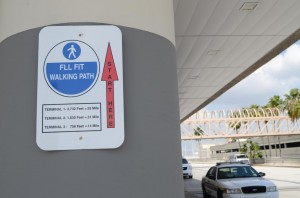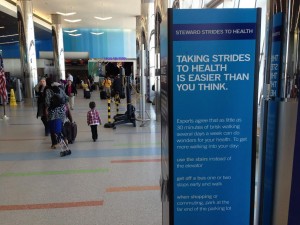“Move along, please.”
That’s the message an increasing number of airports are giving passengers by posting signs and distributing maps and brochures identifying the number of steps and/or the actual mileage between gates, concourses and terminals.
“If your psyche can handle the moving obstacles – also known as people – airports are natural walking paths,” said Erin Kaese, managing editor of the Athletic-Minded Traveler, “and designated paths mean one’s thoughts can more easily wander.”
Some of the first walking paths at airports were created with employees’ heath in-mind. But everyone is encouraged to go the distance and follow the markers in the corridors at airports in Indianapolis, Minneapolis-St. Paul, Baltimore, Atlanta and Cleveland, where health-related messages are posted on columns along the two-mile CLE Health Walk path first set up in 2010 in partnership with the American Heart Association and the city’s health department.
“Passengers who have time before a delayed flight or layover can get a little exercise in by taking a walk through the airport,” said Jacqueline Muhammad, Community Relations manager for Cleveland Hopkins International Airport. “Employees can do the same during their breaks or lunch hour.”
Beyond burning calories, seeing a valuable collection of Northwest-inspired art is the reward at Seattle-Tacoma International Airport (SEA), where a half-mile mosey to the end of Concourse A passes by sixteen permanent art installations and a variety of rotating temporary exhibits. Skip the moving walkways on the way back to the central terminal and you’ve logged an easy, entertaining mile.
Art is also part of the program at Dallas-Fort Worth International Airport, where the LiveWell Walking Path stretches seven-tenths of a mile in Terminal D, past tiled floor medallions and ending, conveniently, at the airport’s yoga studio.
As part of the Steward Health Care-sponsored Strides for Health program at Boston Logan Airport, there are not only walking paths, but health stations where passengers can check their blood pressure, height, weight and body mass index (BMI).
Eight-foot-tall signs explain how easy it is to burn calories on a layover and free maps detail the walking paths and the length between concourses and terminals.
“I see this as the norm moving forward,” said Brad Jersey, founder and CEO of the nLIVEN Group, which put together the program for Logan and is working on bringing it to other airports. Jersey notes that there’s “pressure on airport authorities to provide healthy avenues and choices for the passengers today.”
The latest airport to join the walking path craze is Phoenix Sky Harbor, which earlier this month unveiled its two-mile, post-security, PHX Fitness Trail inside Terminal 4.
The circuit takes passengers past water-bottle refill stations and offers great views of Camelback Mountain, Piestewa Peak and the PHX Sky Train bridge, which passes right over an active taxiway.
“We were aware that passengers on layovers enjoy the views from Terminal 4, which serves eighty percent of our passengers, and are often looking for an opportunity to get some exercise between flights,” said airport spokeswoman Julie Rodriguez.
While MSP airport has post-security lockers where walkers can store carry-ons, PHX does not. “But look at it his way,” PHX noted in its Fitness Trail announcement, pulling a roller bag or backpack along the route is “added cardio.”
Not all the airport walking paths are indoors.
Fort Lauderdale-Hollywood International Airport has a 1.3-mile FLL Fit Walking Path between the terminals and a bag-storage concession where passengers can leave their carry-ons. There’s also the 12.5-mile BWI Trail circling Baltimore/Washington International Airport, which has a paved trail, an observation area for watching planes take off and land, and a park with a playground.
On its website, San Diego International Airport notes that there’s a shared-use path for bicyclists and pedestrians connecting the airport to Little Italy and downtown San Diego to the east and to Liberty Station and Point Loma to the west.
And then there’s the hike passengers can take near Anchorage International Airport. After stashing carry-ons at one of the baggage storage concessions, many travelers head for the 4.2-mile paved trail surrounding the Lake Hood Seaplane Base, the busiest seaplane base in the world.
“Just go out the front door and start walking,” said airport manager John Parrott. “Really, it’s just about that easy.”
To get more information about many of these walking paths, as well as mileage information for routes at other airports, use this helpful tool on the American Heart Association website.
(My story about hiking at airports first appeared in my At the Airport column on USATODAY.com)
Thanks for visiting Stuck at the Airport. Subscribe to get daily travel tidbits. And follow me on Twitter at @hbaskas and Instagram.


